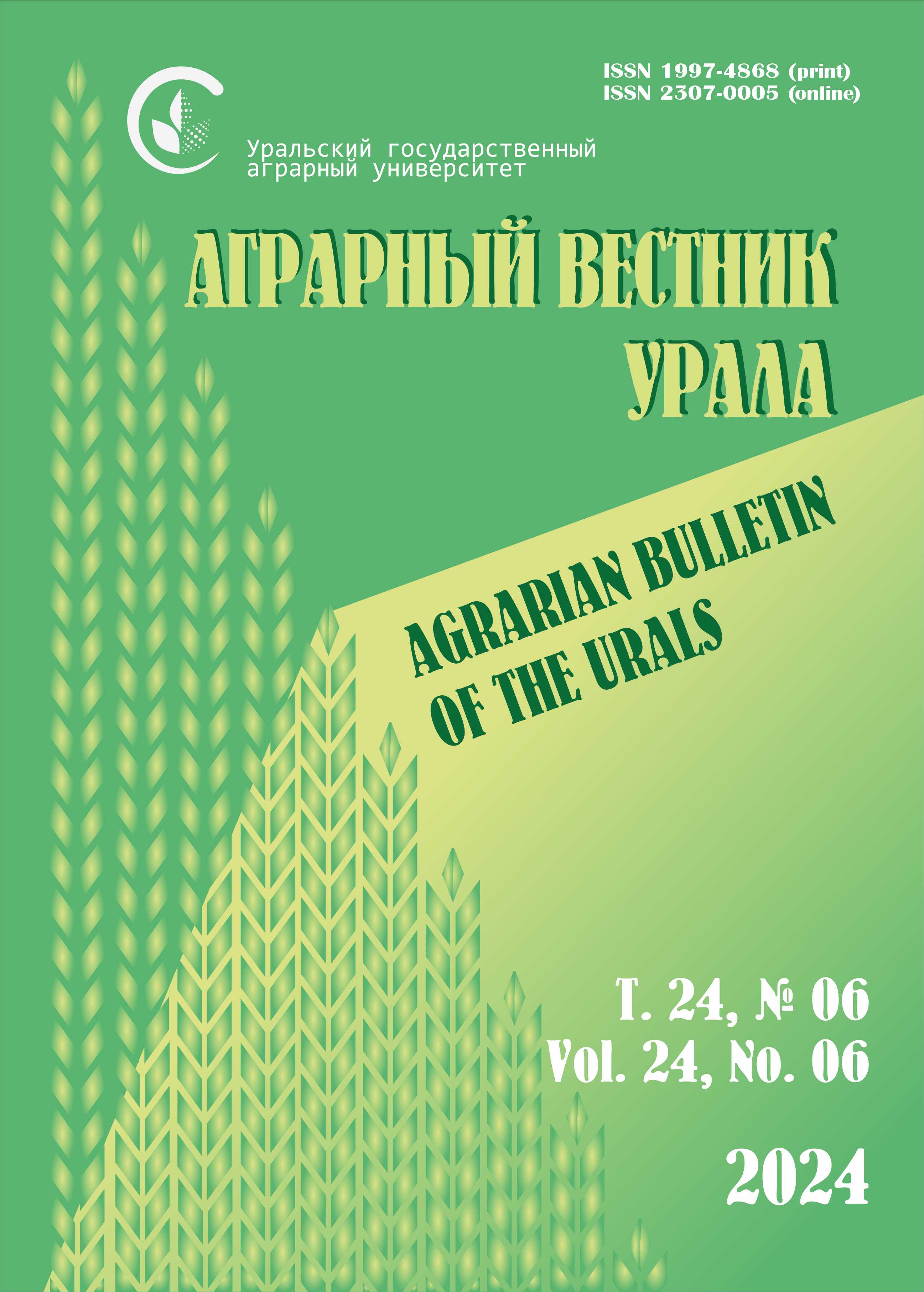Abstract. The purpose is to study the features of morphofunctional changes in the gastric mucosa of fattening pigs in gastric ulcer disease and to establish a possible correlation between pathological changes and colonization of the gastric mucosa of H. suis. Methods. The study is based on pathoanatomic, microscopic, molecular genetic and histological research methods. Results. In 86 % of cases, significant pathomorphological changes in the gastric mucosa of pigs were detected during a pathoanatomical autopsy. Spiral-shaped microorganisms in smears were found in 28 %, H. suis DNA on the gastric mucosa – in 76 %. In the examined samples in which H. DNA was found. suis in the gastric mucosa, 76.3 % revealed various pathologies in the esophagus, 92% revealed various pathologies on the gastric mucosa. In 24 %, when H. suis DNA was not detected, 33.3 % showed no visible damage and 66.7 % revealed various pathologies. The results of the correlation between morphological changes in the gastric mucosa and its infection with helicobacter reached the limits of statistical reliability. Histological methods revealed that active chronic gastritis was detected in 48.0 %, inactive chronic gastritis was detected in 34.0 % and the norm (almost the norm) was found in 8.0 %. Chronic gastritis during exacerbation was reliably diagnosed in 55.2 % of cases when H. suis DNA was detected on the gastric mucosa. Chronic gastritis during remission was diagnosed in 34.2 % of cases when H. suis DNA was detected on the gastric mucosa. The results presented in the work reflect the undoubted connection between the presence of H. suis and the development of gastritis in pigs.
H. suis, pigs, gastric mucosa, gastric ulcer
1. Balabanova V. I. Patomorfologiya i patogenez bolezney otkormochnyh sviney v hozyaystvah promyshlennogo tipa: dis. … doktora veterinarnyh nauk: 06.02.01. Sankt-Peterburg, 2020. 347 s. EDN: https://elibrary.ru/EMYUQA
2. Tereshko A., Petrovskiy S. Ocenka znachimosti benzidinovoy proby pri diagnostike yazvennoy bolezni zheludka u svinomatok // Inovații în zootehnie și siguranța produselor animaliere – realizări și perspective. 2021. S. 753–757.
3. Berrios R., Yensen S. S., Van Lankvel'd A. Yazvennaya bolezn' zheludka u sviney – ser'eznaya problema blagopoluchiya i zdorov'ya v svinovodstve // DanBred. Original'naya datskaya sistema razvedeniya sviney. 2020. URL: https://danbred.com/sb/yazvennaya-bolezn'-zheludka-u-sviney-s (data obrascheniya: 01.01.2024).
4. Yazvennaya bolezn' zheludka sviney [Elektronnyy resurs] // Portal promyshlennogo svinovodstva. URL: https://piginfo.ru/disease/yazvennaya-bolezn-zheludka-sviney (data obrascheniya: 3.01.2024).
5. Tereshko A. N., Bol'shakova E. I., Petrovskiy S. V. Izmenenie haraktera povrezhdeniy slizistoy obolochki zheludka svinomatok pri yazvennoy bolezni v zavisimosti ot kolichestva oporosov // Aktual'nye problemy intensivnogo razvitiya zhivotnovodstva. 2022. № 25-2. S. 306–312. EDN: https://elibrary.ru/SVWEZF
6. Koshkarev M. V., Sadvakasova M. A. Patomorfologicheskaya diagnostika sluchaev padezha sviney v tehnologicheskih gruppah oporosa i doraschivaniya na svinokomplekse // Aktual'nye problemy veterinarnoy nauki i praktiki: sbornik materialov Vserossiyskoy (nacional'noy) nauchno-prakticheskoy konferencii. Omsk, 2021. S. 35–40. EDN: https://elibrary.ru/SPAZRL
7. Balabanova V. I., Kudryashov A. A. Patologoanatomicheskie izmeneniya u otkromochnyh sviney, ustanovlennye pri posleuboynom osmotre // Aktual'nye voprosy veterinarnoy biologii. 2019. № 2 (42). S. 69–74. DOI:https://doi.org/10.24411/2074-5036-2019-10029. EDN: https://elibrary.ru/KFJNBU
8. Klinger J., et al. Agricultural holdings and slaughterhouses’ impact on patterns of pathological findings observed during post-mortem meat inspection // Animals. 2021. Vol. 11, No. Article number. 1442.
9. Taillieu E., et al. Gastric Helicobacter species associated with dogs, cats and pigs: significance for public and animal health // Veterinary Research. 2022. Vol. 53, No. 1. Article number 42. DOI:https://doi.org/10.1186/s13567-022-01059-4 EDN: https://elibrary.ru/POLGBS
10. Berlamont H., et al. Antimicrobial susceptibility pattern of Helicobacter suis isolates from pigs and macaques // Veterinary microbiology. 2019. Vol. 239. Article number 108459. DOI:https://doi.org/10.1016/j.vetmic.2019.108459.
11. Pegu S. R., et al. Incidences of Helicobacter infection in pigs and tracing occupational hazard in pig farmers // Comparative Immunology, Microbiology and Infectious Diseases. 2024. Vol. 106. Article number 102128. DOI:https://doi.org/10.1016/j.cimid.2024.102128. EDN: https://elibrary.ru/AAZDBM
12. Taillieu E., et al. The role of Helicobacter suis, Fusobacterium gastrosuis, and the pars oesophageal microbiota in gastric ulceration in slaughter pigs receiving meal or pelleted feed // Veterinary Research. 2024. Vol. 55 (1). Article number 15. DOI:https://doi.org/10.1186/s13567-024-01274-1. EDN: https://elibrary.ru/SYTTKZ
13. Queiroz D. M. M., et al. A spiral microorganism in the stomach of pigs // Veterinary microbiology. 1990. Vol. 24, No. 2. Pp. 199–204.
14. Nurgaliev F. M. Vyyavlenie bakteriy Helicobacter suis u sviney raznyh vozrastnyh grupp // Veterinariya segodnya. 2020. № 4 (35). S. 266–271. DOI:https://doi.org/10.29326/2304-196X-2020-4-35-266-271. EDN: https://elibrary.ru/ZFZNKZ
15. Matsui H., et al. Development of serological assays to identify Helicobacter suis and H. pylori infections // iScience. 2023. Vol. 26 (4). Article number 106522. DOI:https://doi.org/10.1016/j.isci.2023.106522. EDN: https://elibrary.ru/EBZOTQ
16. Cortez Nunes F., et al. Molecular detection of Helicobacter spp. and Fusobacterium gastrosuis in pigs and wild boars and its association with gastric histopathological alterations // Veterinary Research. 2022. Vol. 53 (1). Article number 78. DOI:https://doi.org/10.1186/s13567-022-01101-5. EDN: https://elibrary.ru/DUOXVX
17. Hessing J. J. C., et al. Changes in the mucous membrane of the pars oesophageal part of the stomach – prevalence and relations to stress // Tijdschr Diergeneeskd. 1992. Vol. 117. Pp. 445–450.









